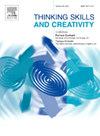Exploring differences in learners' learning processes across collaborative knowledge construction tasks of diverse complexity: A multiple analysis
IF 3.7
2区 教育学
Q1 Social Sciences
引用次数: 0
Abstract
A growing amount of attention has been paid to collaborative learning in the field of education. Group members' collaborative knowledge construction plays an important role in successful collaborative learning. Evidence has proven the implicit character of learners' collaboration and the fact that tasks of diverse complexity can promote the development of learners' cognitive abilities in different aspects. So we investigated how learners' collaborative knowledge construction processes varied across tasks of diverse complexity levels, combining explicit behavior with implicit physiological indicators. This study used content analysis, hyperscanning technology based on electroencephalograms (EEG), and epistemic network analysis (ENA) to analyze the data of 28 triads who participated in two 30-minute online collaborative tasks. According to the frequency results, learners' asking questions and planning (TaskPlan) behaviors in collaborative design tasks are significantly higher than those in collaborative concept explanation tasks. The ENA results further demonstrate that, in comparison to collaborative concept explanation tasks, the connectivity coefficients between asking questions and mutual understanding, planning (SociPlan) and mutual understanding, alongside monitoring (SociMoni) and mutual understanding are all higher in collaborative design tasks. Additionally, EEG data show that learners had higher inter-brain synchronization in the collaborative design task compared to the collaborative concept explanation task. The comprehensive analysis of multiple data points to the fact that in collaborative concept explanation tasks, learners place greater emphasis on the comprehension and construction of concepts, while in collaborative design tasks, learners attach more importance to social interactions among team members which calls for more asking questions and planning behaviors. The research findings can help teachers understand the collaborative learning processes of diverse complexity tasks. They can also give learners more specialized guidance and support accordingly.
求助全文
约1分钟内获得全文
求助全文
来源期刊

Thinking Skills and Creativity
EDUCATION & EDUCATIONAL RESEARCH-
CiteScore
6.40
自引率
16.20%
发文量
172
审稿时长
76 days
期刊介绍:
Thinking Skills and Creativity is a new journal providing a peer-reviewed forum for communication and debate for the community of researchers interested in teaching for thinking and creativity. Papers may represent a variety of theoretical perspectives and methodological approaches and may relate to any age level in a diversity of settings: formal and informal, education and work-based.
 求助内容:
求助内容: 应助结果提醒方式:
应助结果提醒方式:


